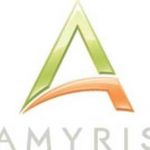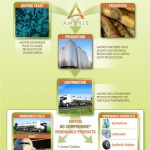BioAmber’s $150 Million IPO: The 10-Minute Version
Jim Lane A first-to-market leader in bio-succinic acid comes to the public markets with its IPO. Can BioAmber translate a lead in succinic acid’s smallish market into leadership in a vast array of high-priced renewable chemicals? Here’s our 10-minute version of the BioAmber IPO, with a translation of the risks into English. In Minnesota, BioAmber has filed an S-1 registration statement for a proposed $150 million initial public offering. The number of shares to be offered in the proposed offering and the price range for the offering have not yet been determined. The lead book-running managers for...
From Fuel To Fudge
by Debra Fiakas CFA This week the last reminder of the renewable fuels business that was once called Solazyme will be gone. The old Solazyme has abandoned the goal of producing renewable fuels using the oils from algae. Instead, under a new name TerraVia, the company is directing its algae cultivation and harvesting knowhow toward growing edible algae for food and personal care products. To make the change complete the old stock symbol ‘SYZM’ gives way this week to a new trading symbol ‘TVIA.’ No doubt there is more than just a little hope in Terra...
BioAmber Launching Asian Joint Venture
Amber Waves of Gain In South Korea, BioAmber (BIOA) and CJ CheilJedang Corporation signed a LOI for a joint venture in China to produce up to 36,000 metric tons of bio-succinic acid per year. It’s not a greenfield. The CJCJ JV involves a retrofit of an existing fermentation plant in a market that BioAmber cannot readily penetrate today. How is BioAmber able to convert this plant? It comes down to a low pH yeast, which allows us to leverage CJCJ’s existing fermenters and purification equipment. The retrofit will allow the partners to bring this capacity on line quickly,...
Biofuels & Biobased Earnings Roundup: Amyris
by Jim Lane
The Top Line. In California, Amyris (AMRS) reported Q2 GAAP revenue for the second quarter of 2018 of $24.8 million, compared with $25.7 million for the second quarter of 2017. Grants and collaborations revenue was $11.4 million for the second quarter of 2018 compared with $10.3 million for the year-ago period. The company noted that Q2 revenue was $24.8 million compared with the same period in 2017 of $21.7 million when adjusted for the low margin product sales on contracts assigned to DSM (DSM.AS). This reflects 15% growth on an absolute basis. GAAP net loss for the first half was $89.1...
Can Amyris Find The Ingredients Of Success?
In late August 2018, sustainable ingredients developer Amyris (AMRS: Nasdaq) staged a successful secondary offering by a selling stockholders, Foris Ventures and Vivo Capital Fund. In conjunction with the offering the company raised $46.0 million in new capital through the exercise of warrants held by existing shareholders. Last week the shares closed over 40% higher than the $6.25 deal price. The chief executive officer lauded shareholders for their support and apparent endorsement of the company’s game plan to commercialize sustainable alternatives to petroleum-sourced materials used in fragrance, health and beauty products.
Amyris leadership should celebrate its loyal shareholders given how far the company drifted...
5 Minute Guide to BioAmber
Jim Lane A quick overview of BioAmber (BIOA) Company description From the company’s 2013 S-1: “Our proprietary technology platform combines industrial biotechnology, an innovative purification process and chemical catalysis to convert renewable feedstocks into chemicals that are cost-competitive replacements for petroleum-derived chemicals. The development of our current organism was originally funded by the DOE in the late 1990s, was further developed and scaled up, and optimized at the large-scale manufacturing facility in France. “We manufacture our bio-succinic acid in a facility using a commercial scale 350,000 liter fermenter in Pomacle, France…We have produced 487,000 pounds, or 221 metric...
Leather Without The Cow
Flokser launches Artificial Leather based on DuPont Tate & Lyle, BioAmber ingredients Jim Lane In Canada, BioAmber (BIOA) announced that the Flokser Group has successfully developed an innovative artificial leather fabric using bio-based materials supplied by DuPont (DD) Tate & Lyle Bio Products and BioAmber. Flokser has launched this new synthetic leather fabric under its SERTEX brand. The novel fabric comprises a polyester polyol made from BioAmber’s Bio-SA bio-based succinic acid and DuPont Tate & Lyle Bio Products’ Susterra bio-based 1,3-propanediol. Flokser’s artificial leather fabric has 70% renewable content and delivers improved performance. It provides better scratch resistance...
Gevo: Are We There Yet?
by Debra Fiakas CFA The renewable chemicals and biofuel company Gevo, Inc. (GEVO: Nasdaq) is scheduled to report fourth quarter 2013 financial results on March 25th. Analysts have a couple of weeks to prepare questions for management during the earnings conference call. Top on the list has to be got to be about Gevo’s recent agreement to license its novel isobutanol technology to Porta Hnos of Argentina. Porta Hnos is a well established ethanol producer so if the license is consummated, it is expected that this partner has the ability to execute on plans to produce isobutanol for...
Dyadic Sells Industrial Technology Business To Dupont
Jim Lane As Dyadic cashes out of industrial biotech and retains a C1 license for pharma, DSM and Syngenta also announce a partnership. Companies are girding their loins for the long haul. The Digest takes a look, In Florida, DuPont (DD) Industrial Biosciences will acquire substantially all of the enzyme and technology assets Dyadic’s (DYAI) Industrial Technology business for $75 million, including Dyadic’s C1 platform, a technology for producing enzyme products used in a broad range of industries. DuPont has granted back to Dyadic co-exclusive rights to the C1 technology for use in human and animal pharmaceutical...
Beets to Gas
by Debra Fiakas, CFA
In recent weeks management from Global Bioenergies (ALGBE: EURONEXT)made the rounds among New York City investors. The French specialty chemical developer is trying to win new friends in the U.S. for its bio-isobutene made through the fermentation of organic materials. Isobutene, also called isobutylene, is a four-molecule hydrocarbon that is a foundational chemical in a wide range of common products from gasoline additives to cosmetics. Until recently, isobutene was made exclusively in the crude oil refinement process. It is one of the many by-products of crude oil refining that helps pad the profit margins of big oil...
Lower Revenues at Solazyme, But Also Lower Losses and New Customers
Jim Lane In California, Solazyme (SZYM) reported Q2 revenues of $11.7M compared with $15.9M in Q22014. GAAP net loss was $37.2 million for Q2 2015, compared to net loss of $42.9M in the prior year period. The company said that “year over year decline in revenues was due to expected decreases in funded program revenue as well as in product revenue due to the timing of certain Algenist sales activities and slower than anticipated adoption rates for Encapso.” The market responded to the results by slashing the stock price 20 percent in Friday trading. Analyst reaction was more positive,...
Impossible Foods Launches Impossible Pork
by Helena Tavares Kennedy
It began with beef without the cow, even leather without the cow, and now we wave goodbye to pork from the pig with the news that Impossible Foods has launched pork made from plants.
Not only that, but Impossible Foods is going beyond the Impossible Whopper and expanding their work with Burger King in a new Impossible Croissan’which using Impossible Sausage made from plants as well. That will be available in only some Burger King locations starting in late January.
What’s in it?
Impossible Foods says their new pork protein is mostly made with soy protein, coconut oil, sunflower oil....
Elevance’s $100M IPO: The 10-Minute Version
Jim Lane Like to quickly understand the surge in renewable chemicals and one of the hottest companies in the hottest sector of the bioconomy? Here’s our 10-minute version of the IPO from Elevance Renewable Sciences. Complete with the risks, translated into English from the original SEC-speak. In Illinois, Elevance Renewable Sciences filed its S-1 registration statement relating to a proposed $100 million initial public offering. The number of shares to be offered and the price range for the offering have not yet been determined. The company indicated that it has apply to list the stock on NASDAQ under the ERSI symbol. The...
Mitsui Raises Stake In BioAmber JV
Jim Lane In Canada, Mitsui has invested an additional CDN$25 million in the BioAmber (BIOA) joint venture for 10% of the equity, increasing its stake from 30% to 40%. Mitsui will also play a stronger role in the commercialization of bio-succinic acid produced in Sarnia, providing dedicated resources alongside BioAmber’s commercial team. BioAmber will maintain a 60% controlling stake in the joint venture. “Mitsui is continuously committed to renewable chemistry and through our increased equity stake we will be more actively involved in joint venture management and sales, leveraging our global sales platforms,” said Hidebumi Kasuga, General Manager, Specialty...
Amber Means Caution But BioAmber Means Go
Jim Lane In Canada, BioAmber (BIOA) recorded net income of $4.8M for Q2 2016 and an operating loss of $1.0M on revenues of $2.5M. Revenues were up 73 percent over Q1 and 637 percent compared to Q2 2015. For those less familiar with the company, it produces succinic acid from sugar at a first commercial-scale plant which opened recently in Sarnia, Ontario. Succinic acid has a small existing global market but can be converted into a variety of chemical building blocks used to produce a range of plastics, paints, textiles, food additives and personal care products. If for...
Why Traffic Lights Are Turning Green For BioAmber
Jim Lane As many technologies pivot or delay, one train keeps chugging on its route to biosuccinic acid, and markets like BDO, resins and polyols. What is it about the business model that keeps on working? What can every integrated biorefinery learn from its approach? In Minneapolis, BioAmber (BIOA) just announced a contract to supply a minimum of 80% of PTTMCC Biochem’s total bio-succinic acid needs until the end of 2017. PTTMCC Biochem is a joint venture established by Mitsubishi Chemical and PTT, Thailand’s largest oil and gas company, to produce and sell polybutylene succinate (PBS),...





